
a.
To calculate: The linear regression models for the populations of both cities using the given data.
| Time (years) | Philadelphia (thousands) | Phoenix ( thousands) |
| 1980 | 1688 | 790 |
| 1990 | 1586 | 983 |
| 2000 | 1517 | 1321 |
| 2010 | 1526 | 1446 |
| 2015 | 1567 | 1563 |
The obtained matrix is
Given Information:
The table is defined,
| Time (years) | Philadelphia (thousands) | Phoenix ( thousands) |
| 1980 | 1688 | 790 |
| 1990 | 1586 | 983 |
| 2000 | 1517 | 1321 |
| 2010 | 1526 | 1446 |
| 2015 | 1567 | 1563 |
Calculation:
Consider the given table,
| Time (years) | Philadelphia (thousands) | Phoenix ( thousands) |
| 1980 | 1688 | 790 |
| 1990 | 1586 | 983 |
| 2000 | 1517 | 1321 |
| 2010 | 1526 | 1446 |
| 2015 | 1567 | 1563 |
Use a graphing calculator to find the linear rgeression.
Step 1. Insert the table in calculator by using the table feature.
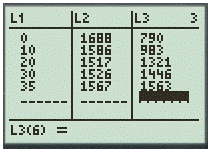
Step 2. Use the LinReg feature with first two list
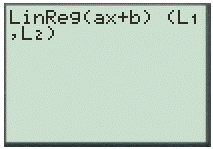
And,
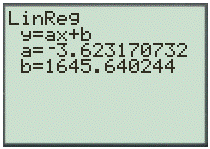
Step 3. Use the LinReg feature with first two list
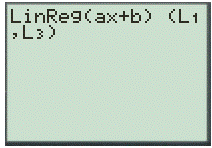
And,
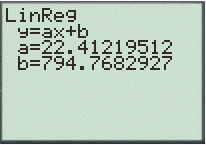
Step 4. Use the Graph feature to plot the both the graph as scatter graph.
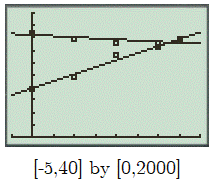
Therefore, the obtained equation is
b.
To calculate: The time when the populations of the two cities were the same as well as the common population of the two cities.
The obtained result is
Given Information:
The equations from the previous part is
Calculation:
Consider the given information,
Equate both the equations
Add the obtained value in 1980.
The corresponding year is 2013.
Now, substitute 33 for
Hence, the obtained result is
Chapter 7 Solutions
PRECALCULUS:GRAPHICAL,...-NASTA ED.
- Find the equation of the line / in the figure below. Give exact values using the form y = mx + b. m = b = y WebAssign Plot f(x) = 10* log 9 Xarrow_forwardA particle travels along a straight line path given by s=9.5t3-2.2t2-4.5t+9.9 (in meters). What time does it change direction? Report the higher of the answers to the nearest 2 decimal places in seconds.arrow_forwardUse the method of disks to find the volume of the solid that is obtained when the region under the curve y = over the interval [4,17] is rotated about the x-axis.arrow_forward
- 1. Find the area of the region enclosed between the curves y = x and y = x. Sketch the region.arrow_forwardfor the given rectangular coordinates, find two sets of polar coordinates for which 0≤θ<2π, one with r>0 and the other with r<0. (-2sqrt(3),9)arrow_forwardI circled the correct answer, could you show me how to do it using divergence and polar coordinatesarrow_forward
- The correct answer is D Could you explain and show the steps pleasearrow_forwardTaylor Series Approximation Example- H.W More terms used implies better approximation f(x) 4 f(x) Zero order f(x + 1) = f(x;) First order f(x; + 1) = f(x;) + f'(x;)h 1.0 Second order 0.5 True f(x + 1) = f(x) + f'(x)h + ƒ"(x;) h2 2! f(x+1) 0 x; = 0 x+1 = 1 x h f(x)=0.1x4-0.15x³- 0.5x2 -0.25x + 1.2 51 Taylor Series Approximation H.w: Smaller step size implies smaller error Errors f(x) + f(x,) Zero order f(x,+ 1) = f(x) First order 1.0 0.5 Reduced step size Second order True f(x + 1) = f(x) + f'(x)h f(x; + 1) = f(x) + f'(x)h + "(xi) h2 f(x,+1) O x₁ = 0 x+1=1 Using Taylor Series Expansion estimate f(1.35) with x0 =0.75 with 5 iterations (or & s= 5%) for f(x)=0.1x 0.15x³-0.5x²- 0.25x + 1.2 52arrow_forwardCould you explain this using the formula I attached and polar coorindatesarrow_forward
 Calculus: Early TranscendentalsCalculusISBN:9781285741550Author:James StewartPublisher:Cengage Learning
Calculus: Early TranscendentalsCalculusISBN:9781285741550Author:James StewartPublisher:Cengage Learning Thomas' Calculus (14th Edition)CalculusISBN:9780134438986Author:Joel R. Hass, Christopher E. Heil, Maurice D. WeirPublisher:PEARSON
Thomas' Calculus (14th Edition)CalculusISBN:9780134438986Author:Joel R. Hass, Christopher E. Heil, Maurice D. WeirPublisher:PEARSON Calculus: Early Transcendentals (3rd Edition)CalculusISBN:9780134763644Author:William L. Briggs, Lyle Cochran, Bernard Gillett, Eric SchulzPublisher:PEARSON
Calculus: Early Transcendentals (3rd Edition)CalculusISBN:9780134763644Author:William L. Briggs, Lyle Cochran, Bernard Gillett, Eric SchulzPublisher:PEARSON Calculus: Early TranscendentalsCalculusISBN:9781319050740Author:Jon Rogawski, Colin Adams, Robert FranzosaPublisher:W. H. Freeman
Calculus: Early TranscendentalsCalculusISBN:9781319050740Author:Jon Rogawski, Colin Adams, Robert FranzosaPublisher:W. H. Freeman
 Calculus: Early Transcendental FunctionsCalculusISBN:9781337552516Author:Ron Larson, Bruce H. EdwardsPublisher:Cengage Learning
Calculus: Early Transcendental FunctionsCalculusISBN:9781337552516Author:Ron Larson, Bruce H. EdwardsPublisher:Cengage Learning





